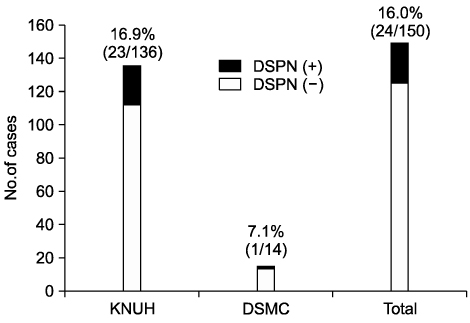Chonnam Med J.
2009 Dec;45(3):161-167. 10.4068/cmj.2009.45.3.161.
Prevalence and Risk Factors for HIV-associated Peripheral Sensory Neuropathy in HIV-infected Adults in Daegu, Korea
- Affiliations
-
- 1Department of Internal Medicine, Kyungpook National University School of Medicine, Daegu, Korea. changhha@knu.ac.kr
- 2Department of Internal Medicine, Keimyung University Dongsan Medical Center, Daegu, Korea.
- KMID: 2274890
- DOI: http://doi.org/10.4068/cmj.2009.45.3.161
Abstract
- Peripheral neuropathies complicate all stages of HIV infection and cause considerable morbidity and disability in HIV-infected individuals. The aim of this study was to describe the prevalence and risk factors of HIV-associated symptomatic distal sensory polyneuropathy (HIV-DSPN) in the HAART era in Daegu, Korea. HIV-infected adults visiting two tertiary teaching hospitals in Daegu during a 2-month period (October 2008 to November 2008) were screened for HIV-DSPN. HIV-DSPN was defined as being present if the patient had neuropathic symptoms or abnormal neurologic signs. Demographic, clinical, laboratory, and treatment data were collected, and statistical analysis was done. One hundred fifty patients (136 patients in Kyungpook National University Hospital and 14 patients in Dongsan Medical Center) were screened. The prevalence of HIV-DSPN was 16.0% (24/150). In the univariate analysis, the statistically significant risk factors for symptomatic peripheral sensory neuropathy were older age [40.6+/-9.4 years in the DSPN(-) group vs. 46.2+/-9.5 years in the DSPN(+) group, p=0.009], diagnosis of AIDS [odds ratio: 4.605 (95% CI: 1.305~16.256), p=0.011], and treatment of tuberculosis [odds ratio: 3.912 (95% CI: 1.352~11.317), p=0.015]. In the multivariate analysis, older age (odds ratio: 1.082, 95% CI: 1.024~1.143, p=0.005) and diagnosis of AIDS (odds ratio: 7.861, 95% CI: 1.330~46.452, p=0.023) were still significant risk factors. HIV-DSPN was not uncommon among ambulatory patients (16.0% prevalence) in Daegu, Korea, and more careful history taking and physical examination for HIV-DSPN should be performed in the management of older AIDS patients.
Keyword
MeSH Terms
Figure
Reference
-
1. Postic B, Horvath JA, Talwani R. Antiviral treatment of human immunodeficiency virus infection: update for 2003. J S C Med Assoc. 2003. 99:148–153.2. Holstein A, Plaschke A, Egberts EH. Lipodystrophy and metabolic disorders as complication of antiretroviral therapy of HIV infection. Exp Clin Endocrinol Diabetes. 2001. 109:389–392.
Article3. Cornblath DR, McArthur JC. Predominantly sensory neuropathy in patients with AIDS and AIDS-related complex. Neurology. 1988. 38:794–796.
Article4. Pettersen JA, Jones G, Worthington C, Krentz HB, Keppler OT, Hoke A, et al. Sensory neuropathy in human immunodeficiency virus/ acquired immunodeficiency syndrome patients: protease inhibitormediated neurotoxicity. Ann Neurol. 2006. 59:816–824.
Article5. Smyth K, Affandi JS, McArthur JC, Bowtell-Harris C, Mijch AM, Watson K, et al. Prevalence of and risk factors for HIV-associated neuropathy in Melbourne, Australia 1993-2006. HIV Med. 2007. 8:367–373.
Article6. So YT, Holtzman DM, Abrams DI, Olney RK. Peripheral neuropathy associated with acquired immunodeficiency syndrome. Prevalence and clinical features from a population-based survey. Arch Neurol. 1988. 45:945–948.
Article7. Morgello S, Estanislao L, Simpson D, Geraci A, DiRocco A, Gerits P, et al. Manhattan HIV Brain Bank. HIV-associated distal sensory polyneuropathy in the era of highly active antiretroviral therapy: the Manhattan HIV Brain Bank. Arch Neurol. 2004. 61:546–551.
Article8. Simpson DM. Selected peripheral neuropathies associated with human immunodeficiency virus infection and antiretroviral therapy. J Neurovirol. 2002. 8:Suppl 2. S33–S41.
Article9. Bacellar H, Muῇoz A, Miller EN, Cohen BA, Besley D, Selnes OA, et al. Temporal trends in the incidence of HIV-1-related neurologic diseases: multicenter AIDS Cohort Study, 1985-1992. Neurology. 1994. 44:1892–1900.
Article10. Affandi JS, Price P, Imran D, Yunihastuti E, Djauzi S, Cherry CL. Can we predict neuropathy risk before stavudine prescription in a resource-limited setting? AIDS Res Hum Retroviruses. 2008. 24:1281–1284.
Article11. Choe KW, Oh MD, Park SW, Kim HB, Kim US, Kang SW, et al. Opportunistic infections and malignancies in 173 patients with HIV infection. Korean J Infect Dis. 1998. 30:507–515.12. Kim JM, Cho GJ, Hong SK, Chung JS, Jang KH, Kim CO, et al. Epidemiologic and clinical features of HIV infection/AIDS in Koreans. Korean J Med. 2001. 61:355–364.13. Kim JM, Cho GJ, Hong SK, Chang KH, Chung JS, Choi YH, et al. Epidemiology and clinical features of HIV infection/AIDS in Korea. Yonsei Med J. 2003. 44:363–370.
Article14. Cherry CL, Wesselingh SL, Lal L, McArthur JC. Evaluation of a clinical screening tool for HIV-associated sensory neuropathies. Neurology. 2005. 65:1778–1781.
Article15. Verma A. Epidemiology and clinical features of HIV-1 associated neuropathies. J Peripher Nerv Syst. 2001. 6:8–13.
Article16. Moore RD, Wong WM, Keruly JC, McArthur JC. Incidence of neuropathy in HIV-infected patients on monotherapy versus those on combination therapy with didanosine, stavudine and hydroxyurea. AIDS. 2000. 14:273–278.
Article17. Watters MR, Poff PW, Shiramizu BT, Holck PS, Fast KM, Shikuma CM, et al. Symptomatic distal sensory polyneuropathy in HIV after age 50. Neurology. 2004. 62:1378–1383.
Article18. Villelabeitia-Jaureguizar K, Rivas-González P, Ibarra-Luzar JI, Fernández-Garcia C, Goyenechea-Herrero A, Frenadas Bravo-Rueda A, et al. Clinical and subclinical neuropathy in patients with human immunodeficiency virus receiving antiretroviral therapy. Rev Neurol. 2006. 42:513–520.19. Ellis RJ, Marquie-Beck J, Delaney P, Alexander T, Clifford DB, McArthur JC, et al. CHARTER Group. Human immunodeficiency virus protease inhibitors and risk for peripheral neuropathy. Ann Neurol. 2008. 64:566–572.
Article20. Schifitto G, McDermott MP, McArthur JC, Marder K, Sacktor N, Epstein L, et al. Dana Consortium on the Therapy of HIV Dementia and Related Cognitive Disorders. Incidence of and risk factors for HIV-associated distal sensory polyneuropathy. Neurology. 2002. 58:1764–1768.
Article21. Lee KS, Chang KH, Choi JY, Park YS, Han SH, Chin BS, et al. Adverse effects of antiretroviral drugs on HIV-infected Koreans. Infect Chemother. 2003. 35:71–77.22. Max B, Sherer R. Management of the adverse effects of antiretroviral therapy and medication adherence. Clin Infect Dis. 2000. 30:Suppl 2. S96–S116.
Article
- Full Text Links
- Actions
-
Cited
- CITED
-
- Close
- Share
- Similar articles
-
- Prevention of HIV Infection in Health Care Setting
- Experience of the Use of Three Screening Kits, Enzygnost Anti-HIV1/2 Plus, ABBOTT TESTPACK HIV- 1/HIV-2 & SERODIA. HIV- 1/2 for the Detection of Antibodies to HIV
- HIV drug resistance in treatment-naive HIV patients
- Rhinosinusitis and Olfactory Dysfunction in HIV-Infected Patients
- Anesthetic Considerations for the HIV-Infected Pregnant Patient


